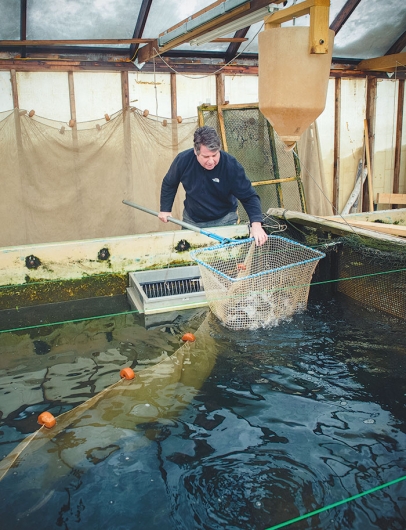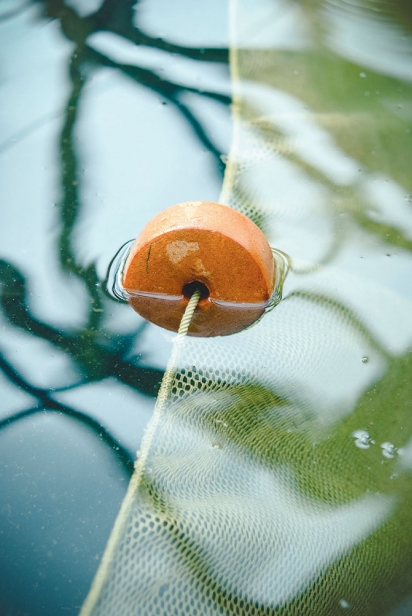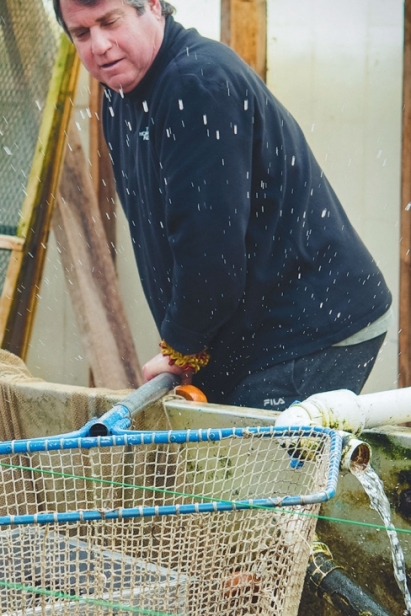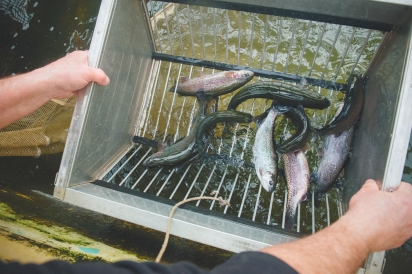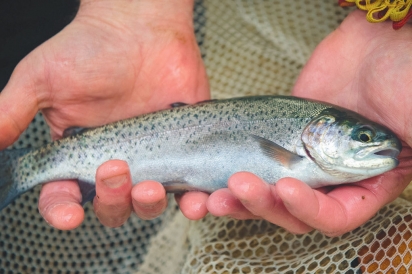From Pond to Table: Danaher Trout Fishery
Matt Danaher is the king of salvaged materials. He gestures with a broad sweep of his arm across his farm. “All those piles out there? My wife calls them junk. But I know where everything is and have a plan for it all.” Neatly stacked greenhouse ribs, 1,000-gallon steel and plastic tanks, pressure treated timbers and PVC drainage pipes.
“You need a big boneyard and a lot of heavy equipment to be a salvage farmer.” And that’s how he converted part of an old dairy farm into Danaher Fishery, the largest privately owned trout hatchery in Vermont.
Matt ducked inside a greenhouse, reached into a bubbling tank, and cupped a score of tiny fry in his work-roughened hands.
“A year and half from now, these trout will be swimming in someone’s fish pond. Or sitting on a dinner plate.” 80% of his trout become pond stock and 20% find their way to some of the state’s top restaurants including the Farmhouse Tap & Grill and Juniper in Burlington, The Inn at Essex, Basin Harbor Club, Downtown Grocery in Ludlow.
In 1983 Matt and his wife, Lori, bought 43 acres of a defunct farm in Shrewsbury. In addition to panoramic views to the mountains of southwestern Vermont, his property boasts excellent spring water. Matt began to terrace the gently sloping land, excavate 11 ponds, lay in water pipe and build four greenhouses mainly with recycled materials or bought second-hand from farms and reconstructed on site. He installed massive tanks and devised a water flow system and by 1991, he had created a fish farm.
“I had a steep learning curve and didn’t make any money till year 15. No one believed it would work. But I stuck with it,” said Matt, 56.
A hearty and charmingly loquacious man, Matt grew up in Colchester and comes from four generations of dairy farmers. He remembers milking at 4am and haying in the summers. How did he get into the fish business? “When my kids were small, they played in a little fish pond I had dug. My daughter was absolutely fascinated so I started to culture fish with her and I guess you could say I got hooked …”
He raises three types of trout: rainbow, brown, brook. “It’s like ice cream flavors. Everyone has a preference but they all taste good!” It takes about 18 months for a trout to grow to 10 or 12 inches. That’s the same amount of time it takes a beef cow to achieve market weight of nearly a ton. And compare that to a standard meat chicken, which gets processed at seven or eight weeks.
In 2014, Matt began to sell his rainbow trout as table fish. He sells about one hundred pounds each week to Earth and Sea Fish Market in Manchester. Matt guts and gills the fish on farm, bags them up, then Earth and Sea picks up the load that same day.
“It’s hard to be both the farmer and the marketer,” Matt said. “I don’t have the time or energy to prepare and deliver my table fish all across the state. So it’s great to work with Bob at Earth and Sea. He does the marketing and shipping for me.”
Retail customers and chefs now have access to buttery fresh trout, with iridescent skin, head still on, eyes firm and bright. Each fish is between 10 to 12 inches long and weighs about 10 ounces. Though he cannot keep up with current demand, he hopes to ramp up his production in the coming years.
“The Vermont-grown local food movement has steadily evolved and people are now willing to pay what food is worth,” Matt said.
So what actually happens at the fish farm? The first step occurs in the hatchery. Matt buys in the eggs, 150,000 in all, and places them in three incubators. Each incubator, a contraption about the size of a large microwave oven, has five sliding trays which are bathed in a steady flow of oxygen-rich water. The eggs hatch in about seven weeks. Rule of thumb: “50 days at 50 degrees.” Called sac fry upon hatching, the miniscule creatures live for the next 30 days on nutrients they absorb from the sac that envelops them. The tiny fry are then transferred to shallow tubs called raceway tanks.
As they grow over the next 14 to 18 months, the fish are graded by size and moved to increasingly larger tanks within a series of greenhouses. After the raceway comes the nursery where the fry will remain until they become fingerlings of four or five inches. At that size, Matt loads them into the rearing facility where the trout will size up from four to 10 inches. Finally, he moves the trout designated as stock fish to the outdoor ponds, while the rainbow trout destined for table fare are placed into the finishing tank until they reach 10 to 12 inches and the desired 10 ounces. This finishing tank can hold up to 5,000 trout, which are continually graded and sectioned off by size.
At every stage, whether greenhouse tanks or outdoor ponds, aerators keep the water bubbling with oxygen. Matt uses a quasi flow-through filter system where recycled water mixes with fresh for optimum conditions. Fresh water is pumped in from a 400-foot-deep well. One of his four greenhouses contains an intricate filtration system that cleanses and recycles all the water flowing to and from his tanks.
He even grows a bed of watercress in one of the filtration tanks. “The roots help clean the water and I get to harvest fresh watercress!” In junior high, Matt did a science project on a water treatment facility. “I never thought I’d be drawing on that same information all these years later,” he chuckled.
Matt or Lori feeds the fish twice a day, tossing handfuls of nutrient-dense pellets into the tanks and ponds. The surface explodes as hundreds of trout vault from the depths to devour the nibs. 150,000 start as swimming fry, though only half will survive to adult stage come spring. About 15–20% will be lost to predation (mink, otters, eagles, osprey, hawks, owls) and others to natural die-off.
Stocking season runs from April to late June, before the ponds warm up. Matt has definitely seen an increase in people stocking their backyard ponds so they can harvest their own fish protein at home, much like people who raise backyard chickens or laying hens. Pond stock can be ordered in two-inch increments from four to 12 inches. He loads the fish into his truck and trailer, equipped with a pair of 300-gallon tanks complete with oxygenated water, and hits the road seven days a week, delivering pond stock trout throughout the state.
“Any day spent behind the windshield with a load of fish in the back beats a day in the office,” said Matt.
He once received a frantic call from a grandfather who promised his grandkids fish in the pond for the Fourth of July. “So I loaded the truck and drove to his place. He was so relieved! I felt like Santa Claus!” However, he also admits that by the end of June, he doesn’t want to look at another trout. At least for a day or two …
Matt’s advice to future aquaculturists? “If you want to go into the fish business, be prepared to spend a boatload of money and work till you’re 90. I started when I was in my early 30s and am just hitting my stride.”
Judging from the piles in his boneyard and plans for future expansion, those same work-roughened hands will keep excavating ponds, building greenhouses and cupping tiny fry for another 40 years.


